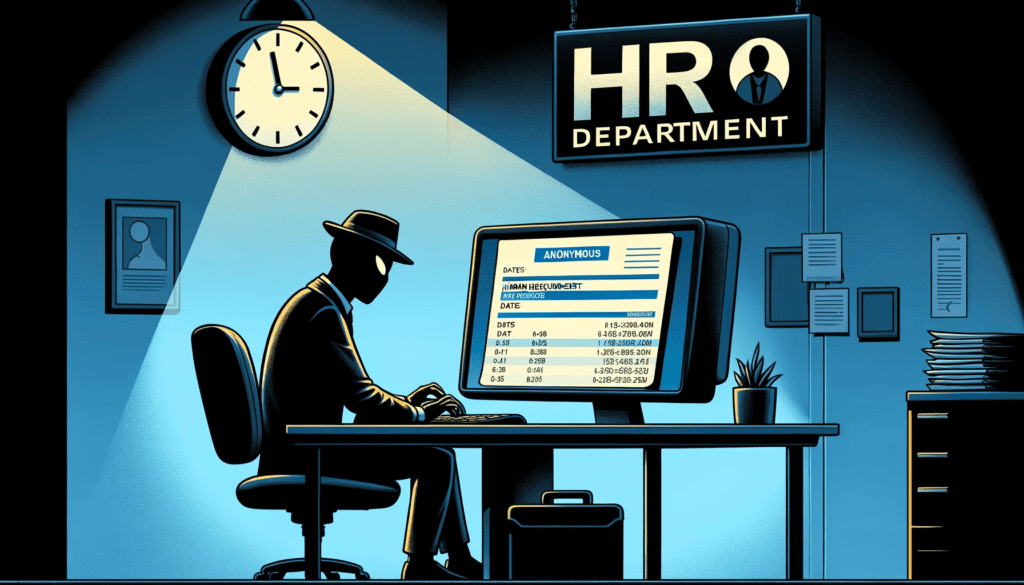Last Updated on December 26, 2023 by Daniel Boyce
Navigating the complexities of workplace conflicts can sometimes lead to considering the dismissal of a colleague.
While driven by various motivations, it’s crucial to approach this with caution and professionalism to avoid personal repercussions.

The most straightforward and responsible methods on how to get someone fired include reporting the individual to HR, discussing the matter with your manager, and ensuring confidentiality to prevent retaliation.
It’s important to maintain written and digital records of the offenses, and if appropriate, engage in a one-on-one conversation with the person involved.
These steps should be taken judiciously, understanding the potential consequences and ensuring that any action is justified and aligns with professional standards.
7 Approaches to Get Someone Fired and Avoid Backlash
Sometimes people just deserve what’s coming to them, and if you know someone who deserves to get fired for revenge, then you need to know how to do it without them knowing.
It’s possible that no one else knows why certain people should be fired, only you.
If you believe that a person deserves to be fired, then you might think it’s all right for you to ensure they get their due.
Whatever the reason, if you feel like someone deserves to be punished for their actions, then getting them fired is one way of ensuring justice is served.
1. Report Them to the Human Resources Department
Reporting someone to their superiors is a powerful way to get them fired, but it can be difficult to do so without being identified.
The first step is to remain anonymous if you want to avoid any potential repercussions.
This can be done by either making the report in person while maintaining your anonymity or by submitting an anonymous report.
When making an anonymous report, it is important to provide as much detail as possible about the individual’s behavior and any evidence that supports your claims, especially if they have turned work into a hostile work environment.
Be sure to include dates, times, and witnesses if applicable.
It is also important to remain professional and stick to the facts when writing up the report.
If you are reporting in person, make sure that you are clear and concise with your accusations and provide evidence if necessary.
By following these steps on how to get someone fired, you can ensure that your report will be taken seriously and result in action against the individual in question.
2. Talk Directly With Your Manager About Their Actions
When it comes to addressing a problem with a co-worker, it is important to go to your manager.
If speaking with the person in question hasn’t produced any results or could lead to an explosive conflict, your best bet is to bring up the issue with your boss.
Before doing so, it might be beneficial to apply a few tips that can help keep the conversation productive.
It’s best to set a time in advance to avoid catching your boss off-guard.

Secondly, make sure you don’t let emotions take control of the conversation.
Don’t sound like you are griping about this person; rather, clearly tell how this individual is generating issues in the workplace for everyone.
By following these tips and having an honest conversation with your manager, you can ensure that the issue will be addressed appropriately.
3. Think About Getting a Written Promise of Anonymity
When it comes to reporting on the condition of anonymity, it is important to make sure that you trust the person or persons you are reporting to.
This means that you must be certain that there is no personal relationship between them and the person you are trying to get fired.
It is also important to get a written promise of anonymity from the boss or HR person before making any reports.
This will ensure that your identity remains confidential and protected.
If you cannot guarantee all three of these conditions, then it may be best not to report on the condition of anonymity.
Although retaliation in the workplace is prohibited, it can be tricky.
In some cases, it may be better to speak up directly and take responsibility for your actions rather than relying on someone else’s promise of confidentiality.
Doing so can help protect both yourself and the person you are trying to get fired from potential repercussions or legal action.
4. Maintain Written Records of Evidence
Paper records are crucial, chronicling a person’s decisions, actions, and events.
They encompass all handled documents, signed or not, such as approvals or unverified papers.
Establishing a paper trail is vital, especially for discussions with managers, and calendars help track attendance at meetings.
These records are key to comprehending a person’s life, revealing their choices and social interactions.
Access to these documents allows for a deeper understanding of an individual’s history and can confirm details or reveal inconsistencies in others’ accounts of their life.
| Type of Written Record | Description | Purpose |
|---|---|---|
| Signed Documents | Papers with signatures indicating approval or review | To provide verified evidence of consent or acknowledgment |
| Unsigned Documents | Papers passed along without signatures | To show the circulation of information without formal endorsement |
| Calendars | Records of presence or absence at meetings or events | To track participation and whereabouts on specific dates |
| Medical Records | Healthcare documentation | To detail a person’s medical history and treatments |
| Court Documents | Legal filings and judgments | To provide official legal evidence and outcomes |
| Business Records | Contracts, reports, financial statements | To outline professional dealings and financial transactions |
| Personal Letters | Written correspondence | To offer insight into personal views and relationships |
| Emails | Digital written communication | To record informal or formal exchanges and decisions |
| Meeting Minutes | Summary of discussions and decisions in meetings | To provide a formal account of proceedings and actions taken |
5. Maintain Digital Records of Evidence
Digital records such as emails and texts are often used in legal proceedings to prove a person’s wrongdoing.
These can be complaints via email, or even emails directly from this coworker. However, video records can also be used to provide evidence of a person’s actions.
If you’re looking to capture a person’s actions, video recordings from office cameras, hallway cameras, CCTV cameras in public areas, or even mini cameras that you use yourself can
This way, you don’t have to worry about finding the right camera at the last minute when it may be too late.
Having access to these video records can make a big difference in proving your case and getting justice for any wrongdoings committed against you.

6. Create Clear Situations That Show Their Offenses
Using indirect means to get someone fired can be an effective way to get rid of someone without resorting to blatant sabotage.
One way to do this is by creating situations that make it difficult for them to continue.
For example, if the coworker is consistently late, extend an invitation to a late-night outing on a work night and then arrange a meeting with your supervisor for early the next morning.
When your coworker doesn’t show up, act confused as to why they wouldn’t be there.
If they have an issue with cursing in front of customers, invite your religious grandfather and his church friends past when they are working and let them complain to the manager instead.
This could include intentionally making it really obvious when they are messing things up, and also obvious it is them.
This will let others draw their own conclusions about this coworker.
Whatever method you choose, using indirect means can be an effective way of getting rid of someone without having to resort to more extreme
7. Talk to Coworkers or Employees One-on-One
When it comes to addressing a problem with a person, the best approach is to try and have a meeting in person.
As long as it is safe to do so, you can respectfully address the issue and keep your focus on solving the problem, instead of getting the person fired.
When discussing the issue with the person, it is important to explain what the problem is and how it affects you or other co-workers.
For example, if someone is consistently late for group meetings, you can explain how this affects everyone’s productivity and ask them to help come up with a solution.
It may also be helpful to suggest potential solutions or compromises that could help resolve the issue.
By taking this approach, you are more likely to find a resolution that works for everyone involved.
Ethical Considerations When Getting Someone Fired
Assessing the Need to Have Someone Fired
When exploring how to get someone fired, it’s vital to consider the ethical implications.
Decisions should be based on solid evidence, not personal grievances, and should be seen as a last resort after exploring other solutions.
Ensure that any evidence is factual and work-related.
Getting someone fired can be a big deal for them and impact the future of their career.
Misrepresentation or fabrication not only breaches ethical standards but can also have legal repercussions.
Confidential Reporting
If proceeding with termination, maintain professionalism and confidentiality.
Anonymous reports or formal complaints should focus on work impact rather than personal issues.
In cases of hostile work environments, dismissal through formal channels is justified, provided it’s backed by valid evidence.

Reflecting on Motives and the Situation
Before taking action, reflect on your motives to ensure they are professionally justified and not driven by personal biases.
This ensures that your actions align with ethical and professional standards.
Conclusion
Deciding to get someone fired, especially anonymously, is a significant step that should be approached with caution and for justifiable reasons.
40% of Americans have been fired and it takes up to 20% of their salary, in new hire acquisition costs, to replace them.
This is why many companies try to only fire an employee as a last resort.
Documenting incidents and discussing the situation with a supervisor or manager is essential.
Remember, companies often view termination as a last resort due to the high costs involved in replacing an employee.
If termination is deemed necessary, ensure it’s done in line with company policies and ethical standards.
It’s important to act not out of spite or jealousy, but based on clear evidence of wrongdoing.
Ultimately, the decision to pursue anonymous action should be carefully considered, weighing both the need for justice and the potential impact on your professional standing.

Daniel Boyce, founder of AwareRecruiter.com, brings a diverse background in health, fitness, sales, and recruitment to career development. He’s passionate about helping professionals overcome workplace challenges and succeed in new roles. Daniel’s vision for AwareRecruiter.com is to create a comprehensive resource for career growth and satisfaction.